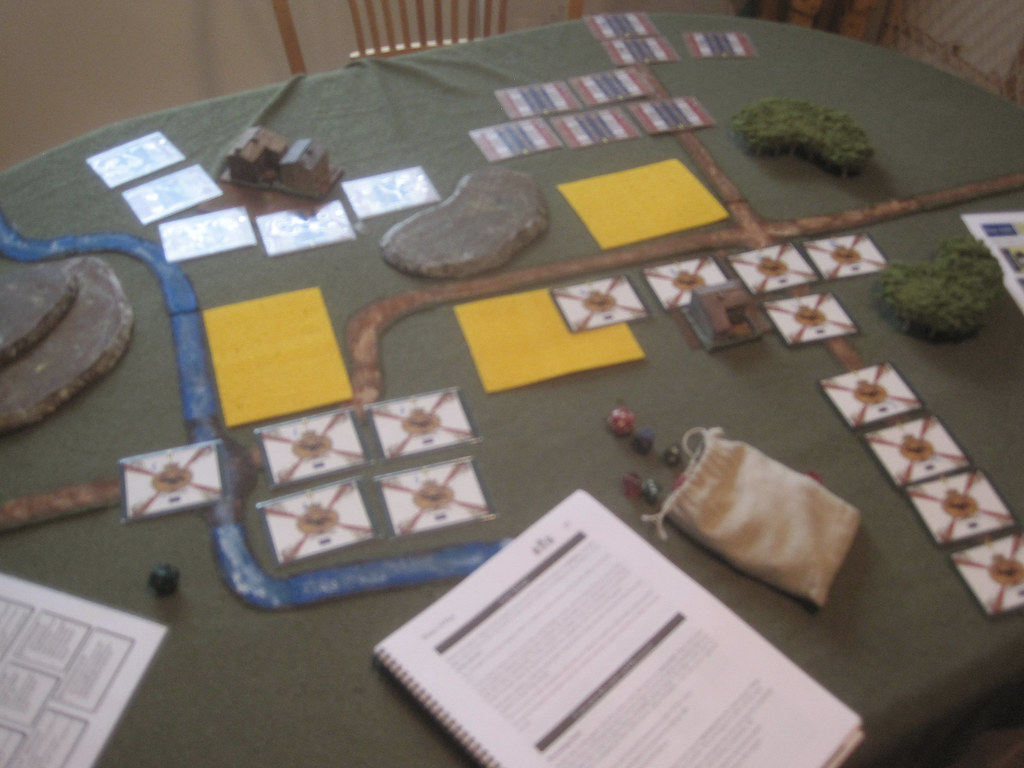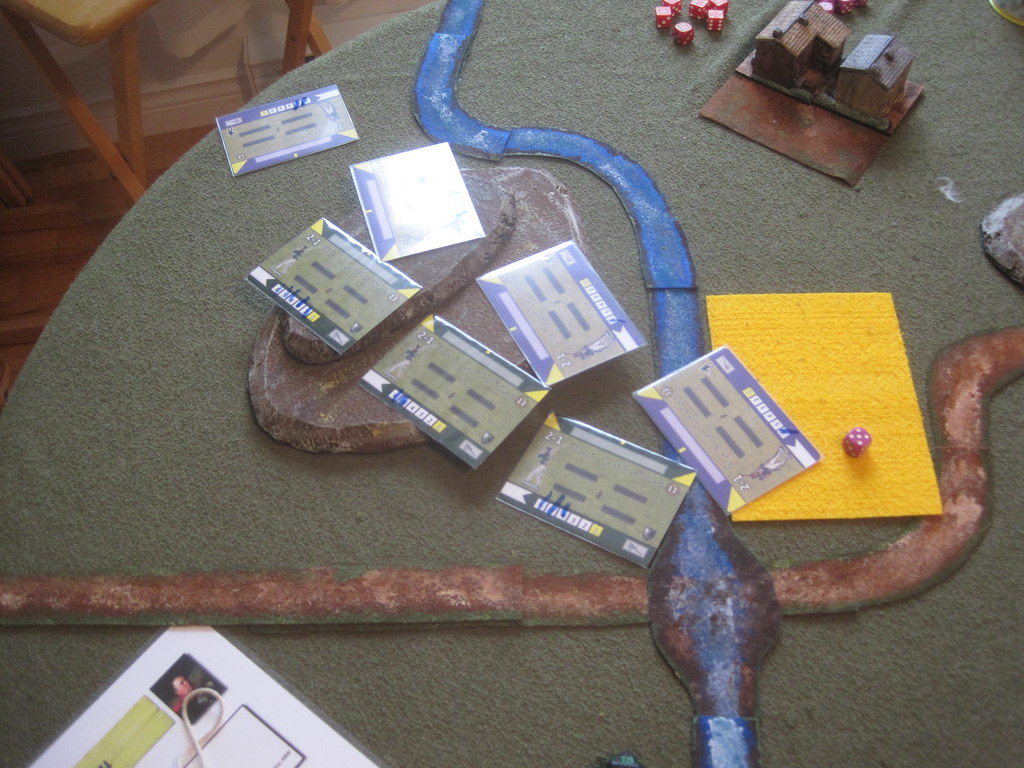Hi all,
Took advantage of a bad weather day to commandeer the dining room table, and run through a trial of the Blucher rules, by Sam Mustafa. These attracted, I think, a fair amount of attention when they came out a few years back, but for those of you unfamiliar, they're his latest run at big-battle rules for the Napoleonic period.
 |
| Glam shot for posting purposes ;) |
Units are brigade to division sized, and they're designed to handle the really big battles of the period. They're also the rules system. for which I've been painting and basing my Napoleonic Russians. I've had the rules for a while, and picked up the cards back around Christmas, but have only now gotten things out for a game.
 |
| Laying out the armies. Cards act as a partial blind. You know something is there, just not what it is. |
Blucher is designed to be played with or without miniatures. Cards can serve as both an introductory game mechanic (so you don't need completed armies prior to play), but also as a partial blind in the earlier stages of the game. I put together some quick and dirty forces (3 core Russians vs. French, with 8 infantry, 3-4 cavalry, and 2 guns apiece), slapped down some terrain, and deployed. Due the limitations of space (I think next time I'll break out the big cardboard underlayer), the front lines deployed close enough to be discovered in the opening turns. Part of me has been thinking that smaller bases might have been a more practical approach for the game (in that table size keys off of of unit footprint), but if I'm doing napoleonics, I'm in it for the spectacle, so bigger bases are more fun.
 |
| My poor old camera. At least part of the pic is in focus ;) |
To give some structure to the game, I had three areas operate as objectives - the two "towns", and the crossroads. The basic idea was an attack by the French to seize a crossroads and river crossing, with the Russians moving to prevent it.
 |
| Russian main line revealed by encroaching French. |
The early stages of the battle saw the French pushing towards the Russian center, and the crossroads, while their cavalry corps tried to turn the Russian right flank, and envelop. The French did try to advance on the Russian left, but found it harder to coordinate the attack on that flank.

That flank attacked was stymied by an absolutely courageous defense conducted by a brigade composed of battalions from the Perm and Sievsk regiments, who ended up holding off a sequence of attacks by waves of cavalry throughout the whole game. "Prepared" infantry, while immobile, gain significant advantages in combat vs. cavalry, and the French inability to coordinate infantry and cavalry together (partly due to terrain), meant they were able to hold the flank.
 |
| View from the French left. |
Attrition in the centre built up, while on the Russian left, both armies were able to eventually coordinate, and the French closed to skirmish distance. They held their ground, and began a steady harrassing fire of the Russian line.
 |
| On the Russian left. The Tsar's men take the hill, but the French move to challenge. |
Some of the mechanisms of Blucher began to assert themselves at this point. Artillery effect is essentially ablative; your guns' firepower degrades over time, as ammunition is used up. The effect is that while artillery can wear down infantry, or if concentrated do real damage, sooner or later, the infantry has to move in. This happened in the game, with both sides eventually using up their ammo, and retiring their guns. Meanwhile, on the right, the Russian brigade still held the line.
 |
| Someone is getting a medal. This brigade held off successive charges from the French cavalry from dawn to around 2pm. |
On the left, the French advantage in skirmishing (they get a bonus, as the Russians do defending in combat), took it's toll, wearing down the brigades anchoring the Russian line. Two of them broke, and the French moved in. In the centre, fire and combat, plus the damage done by artillery, was wearing down both sides. The French had an edge in infantry, but the casualties to the French cavalry compensated, and both sides were getting close to their breaking point.
 |
| The Russian cavalry reserve deploys. |
At this point, the Russians activated their reserves. Blucher allows units still "hidden" to make a reserve move in the game. As long as they don't come too close to the enemy, units can rapidly redeploy in a single turn, and become revealed. The Russians did this to their cavalry, partly to block the French cavalry's attempt to go around the stubborn Russian brigade blocking them, and partly to hold up the French attack on the left, which was gaining momentum.
 |
| The Russian left starting to falter. After a slow start, the French pushed hard here. |
Things were getting tense. Several Russian units were on their last legs, and if the French could push an attack home, it was likely the shaken brigades wouldn't hold. On the other hand, the French cavalry had shattered on the Russian right, and the remnants were driven off by the Russian reserves. The next army to lose a unit, would lose the battle.
 |
| Artillery exhausted on both sides. It's down to the PBI. |
 |
| Can the cavalry ride to the rescue? |
 |
| The Russian brigade anchoring the right is hanging by a thread. |
Then the French unloaded a rippling line of fire, and the Russians, stouthearted as there were, blinked first. Puddin', who was acting as my dice roller and general advisor, rolled a trip six for one French unit, knocking out a Russian brigade. Their whole line recoiled, and the Russians gave up the field.
 |
| Never let the 8-year old roll the dice. Unless she's rolling for me. |
 |
| Undone by skirmish fire. I assume the general was hit, and the whole brigade panicked. |
This turned out to be a ripper of a game - despite it being a rather clumsy learning experience, and not really planned out at all. The game seems to really be about army coordination; getting your bits to act together is really important, but a constant challenge. It feels like you're coordinating an army. The MO mechanic (a blind dice roll acts as a limit to action, but isn't revealed until exceeded) means you are constantly having to prioritize what parts of the battle need the most attention. Combat is attrition-based. Your units wear down to the point where they can become vulnerable, and if you don't have reserves or a second line, a whole wing can collapse with shocking rapidity.
 |
| Left-centre at end of game. |
 |
| On a knife edge. One more turn, and those Russian cavalry would have cracked open the French on the Russian left. |
There's also a ton of untapped depth to the game. I barely touched army building, terrain, and the scenario was strictly instrumental. There's what looks like an excellent "campaign" system to set up battles - sort of a strategic mini-game informing the tactical game on-table. There's also the sheer depth of the period itself. It was also surprisingly conducive to solo play; the dice introduce enough randomness that whatever side you're playing has to react to events, and with a larger table I think the impact of the reserve option will be more evident. Definitely glad I picked the rules up, and I will keep building towards a full army.
FMb

















Dude, I did tell you. :P
ReplyDeleteExcellent walk through, Markus! Russians look super all based up!
ReplyDeleteMy word epic stuff.
ReplyDeleteExcellent Markus !
ReplyDeleteBlücher is really good game!
:-)
Great stuff! Excellent explanation and sounds like lots of fun!
ReplyDeleteBest Iain
Nice impression of the rules. SM tends to write a decent rule set; though taking a few play throughs to get to grips with everything.
ReplyDeleteAnd you can never trust an 8 year old! 😀
She's wily, that's for sure.
DeleteLooks great, I've enjoyed other sets of Sams rules, I should give these a try.
ReplyDeleteGreat report and happy to have another convert to the rules (and lovely 6mm figures btw). Blucher is fun and very nuanced. A couple years ago I ran the Waterloo campaign for our group (6 players) and we had a great time. It all culminated in an epic battle near Hal that saw a hard-fought French victory.
ReplyDelete